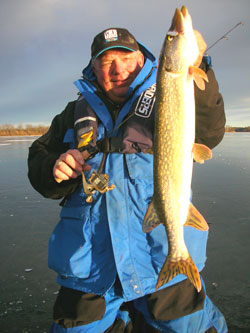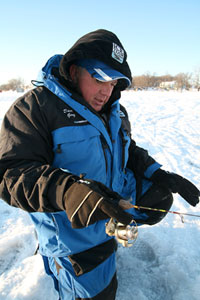 The pursuit of late ice fishing almost always passes through a lumberyard. Pretty much every year, you’ll find Dave Genz and his buddies pounding together planks, which will be used to bridge the open edges of shallow water with the thick but waning ice of opportunity.
The pursuit of late ice fishing almost always passes through a lumberyard. Pretty much every year, you’ll find Dave Genz and his buddies pounding together planks, which will be used to bridge the open edges of shallow water with the thick but waning ice of opportunity.
It might be March in the northern states or April in Canada, but the fishing is just too good to pass up. That is, if you know how to target the right places.
Let’s start with the dynamics.
When it comes to fishing, for every statement you try to make or rule you try to spout, plenty of exceptions come to mind. “But general rules are helpful,” begins Genz, the man who drove the modern ice fishing revolution more than 30 years ago. “At late ice, the best way to put it is you’re looking for larger lakes, and you’re heading to bays on the north side.”
In that one statement sits the nugget of gold that can help you find good fishing every year at this time. Good-size bays on larger lakes, along the north side. A bay on the north side receives southern exposure, which means it gets more life-pumping sunshine on an average day, as late winter prepares to give way to early spring. That part is not exactly news, because primitive man knew to put a south-facing window in the cave, for crying out loud.
But, if anything, modern man is so far removed from the natural world that a quick reminder can be helpful. Besides, there’s more to it than just keying on bays on the north side.
Notice that Genz mentioned larger lakes. That’s important, too.
In places where winter sticks around for several months or more, there is a bit of stagnation that occurs during midwinter. “That’s why we fish those smaller lakes and ponds right away, at the early stage of the winter,” he says. “If a small lake stays frozen over for a long time, it’s usually tough to catch fish out of it as the winter goes along.”
Genz believes that a combination of factors are responsible for this midwinter sluggish behavior, when and where it occurs. The general feeling is that oxygen levels dip to a point that fish look to escape into large areas of deeper water, when available. When they’re not, the theory is that low oxygen is responsible for fish becoming so sluggish as to be impossible to catch.
Genz has, for several years, been advancing his additional theory that water temperature has a lot to do with this, too. It’s his belief that, particularly in smaller bodies of water, the warmest water available to the fish can dip below the classic 39 degrees F normally found around the bottom in deeper water. It’s this great chill, thinks Genz, that kills fishing on smaller lakes and ponds, as much as oxygen levels do.
Now, think about those larger lakes, the ones that continue to kick out fish in late January and February in the heart of the Ice Belt. No matter how nasty or prolonged the winter, it seems that fish can find significant zones with 39-degree water and sufficient oxygen. This, the theory holds, means that fish in larger lakes are typically not as stressed during the ‘midwinter doldrums’ and are coming into the late-ice period in relatively healthy condition.
 Finding Key Late-Ice Locations
Finding Key Late-Ice Locations
As the calendar turns toward the big melt-off, the ice breaks free and eventually thaws partially along shorelines. This creates an inflow of fresh, warm, oxygenated water. Life is thriving under the ice, and fish of many stripes are actively feeding, many of them preparing to spawn. At this time, Genz puts the odds in his favor by seeking out large bays on the north side of large lakes.
It’s a pattern you can use to find great action, too.
“Usually, fish are migrating into those bays during the last part of winter,” says Genz. “And the fish often school by size.”
Even on lakes with a recent reputation for kicking out only small- to medium-size fish, this can be the time of year, and the place, to find bigger-than-average biters.
For many years, people have thought Genz crazy as he continues ice fishing long after they have begun cleaning out tackle boxes and dreaming of launching boats.
“It’s amazing to me,” he says, “because it can’t be any nicer out there on the ice. The sun is warm, there’s hardly anybody out there fishing, and the fish are coming alive.”
Safety First
Yes, late ice can be thick but unsafe. Always wear a life jacket, and fish with friends. Have each person carry a throwable device tied to a rope. Don’t push it after the ice takes on a honeycombed appearance and it becomes easy to punch through with a blunt object.
This is the time of year to give up your truck, car, or even snowmobile/ATV. Walk out onto the ice with a lightweight Fish Trap and only the essential modern ice fishing gear (Vexilar, Lazer auger, rods, small amount of ice-specific tackle such as Lindy jigs, and your life jacket). Bring a bucket or bag for fish you want to keep, and continue moving until you find them.
You often have to ‘plank it’ to get out from rotting shorelines onto thicker ice, and you might have to access north-end bays from the south side of the lake. But those efforts can be worth it, when you find big, biting fish.
“Do this once,” says Genz, “and you won’t be so eager to get the boat out after that.”
Note: Dave Genz, known as Mr. Ice Fishing, was the primary driver of the modern ice fishing revolution. For more, including his instructional DVD on bluegill fishing, go to www.davegenz.com, and www.iceteam.com.










